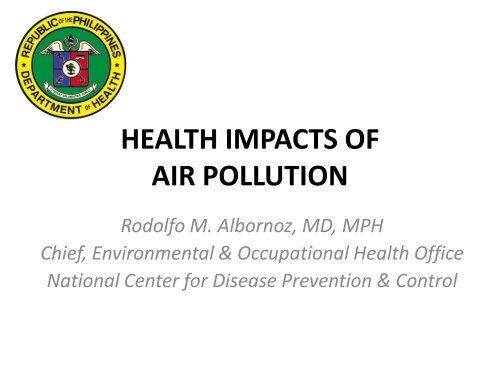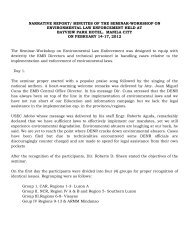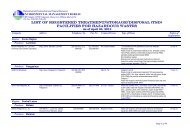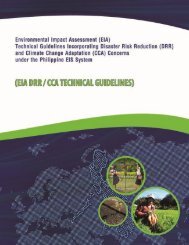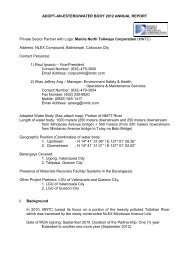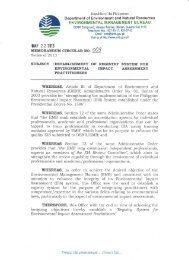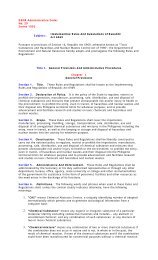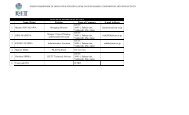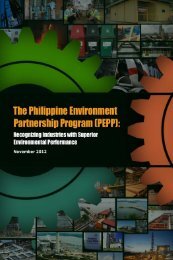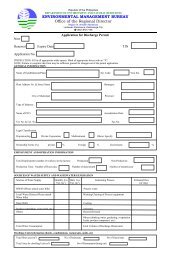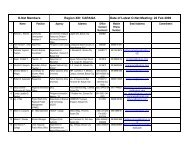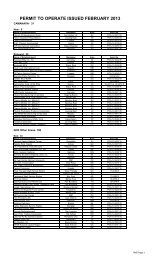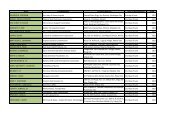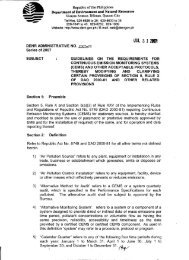HEALTH IMPACTS OF AIR POLLUTION
HEALTH IMPACTS OF AIR POLLUTION
HEALTH IMPACTS OF AIR POLLUTION
You also want an ePaper? Increase the reach of your titles
YUMPU automatically turns print PDFs into web optimized ePapers that Google loves.
Health and the environment link
Health and the environment linkHow the Body Defends itself against Air PollutionRespiratory system - protective mechanisms• nose - hairs, acts as “warning signal” forunpleasant gaseous odors• sneezing, coughing mechanisms• tiny hairs lining in the walls of the respiratoryairways• macrophages - specialized scavenger cells
Health and the environment linkHow the Body Defends itself against Air Pollutionnoseunpleasant gaseous odorshairsparticulate matter, dust, etc.sneezing, coughing mechanismsmouth/throat irritation,difficulty of breathing
Health and the environment linkHow the Body Defends itself against Air Pollutionsneezing, coughing mechanismsmouth/throat irritation,difficulty of breathingChestpains, respiratory tractinfections, asthma, bronchitis,etc.
Health and the environment linkHow the Body Defends itself against Air PollutionGas Exchange Region
Health and the environment linkFactors Affecting Exposure• age• current illness• level of activity at the time of exposure• lifestyle – alcohol, smoking• duration of exposure• nutritional status
Health and the environment linkMost exposed: Transport workers & commutersMost vulnerable population:• Very young ( below 5 years old )• Very old ( above 65 years old )• Pregnant women• Immuno-compromised• With existing respiratory & cardiovascular problems
Deposition of pollutants in the respiratorytract
Source: World Health Organization. Air Quality Guidelines. Geneva, World Health Organization:Department of Protection of the Human Environment, 2005.
Health and the environment linkRespiratory symptoms - most common adverse health effects from airpollution of all types• cough (w/c may produce sputum)• nose and throat irritation• mild shortness of breathPeople with existing respiratory diseases (asthma, chronic obstructivelung disease) -exacerbate or worsen symptomsPeople with bronchitis - increase cough due to increased irritation of thebronchial mucosa
Health and the environment linkCardiovascular effects - (ex. HPN, Heart Disease) particularlysevere among people with existing lung disease• Cancer• Central Nervous System• Cataract• Diabetes Mellitus• Premature Mortality
Children’s unique vulnerability• Children take in more air per unit body weight at a given levelof exertion than do adults• Children are growing and developing.• Children do not necessarily respond to air pollution in the sameway as adults• Children also spend more time outside than adultsSource: Moya. Children’s behavior and physiology and how it affectsexposure to environmental contaminants. Pediatrics. 2004, 113: 996.
Health and the environment linkParticulate MatterWhat is it- Tiny particles suspended in the air- Particles with a diameter less than 10 micrometers are calledrespiratory suspended particulates (RSP) or PM10.- Those less than 2.5 micrometers in diameter are called PM2.5What can it doto you?-This is the air pollutant that poses the biggest threat to human health- It can make it difficult to breathe- It can damage lung tissue- It can aggravate existing cardiovascular diseases and lung problems- Some particles may cause cancer- Particles with a diameter of 2.5 micrometers(PM2.5)are able topenetrate deep into the lungs- The elderly and children are especially vulnerableWhere does itcome from?- Power plants- Car exhausts- All kinds of atmospheric chemical air pollutants and fine particlessuspended in the air such as construction dust, soil, ash and soot.
Health and the environment linkNitrogen Dioxide (NO 2 )What is it?What can itdo to you?Where does itcome from?-A corrosive light brown gas- In sunlight, nitrogen dioxide can react with compoundsin the air to make another hazardous pollutant, ozone- It can irritate the lungs- It can lower resistance to respiratory diseases such asinfluenza- People already suffering from respiratory problems, suchas asthma, are especially vulnerable- It may impair child lung development- It can increase chances of children developing asthma- It may lead to structural changes in the lungs- Power plants- Car exhausts
Health and the environment linkSulfur Dioxide (SO 2 )What is it?- A colourless gas- It has a pungent smell at very high concentrations.What can it doto you?-The latest research shows that even low concentrations ofSO2 can be harmful to your health- It can make it difficult to breathe and affect lung functions- It can irritate the eyes- It can aggravate existing respiratory problems- People sensitive to SO2 may develop symptoms such aswheezing, shortness of breath and coughing- Asthmatics and individuals with cardiovascular disease orchronic lung disease (such as bronchitis or emphysema)as well as children and the elderly are especially vulnerableWhere does itcome from?- Power plants that burn fossil fuels- Vehicles running on sulphur-containing fuels (eg diesel)
OzoneHealth and the environment linkWhat is it?- Called a secondary pollutant because it is not directlyemitted, it is produced by reactions of other pollutants- People are often exposed to ozone pollution in everyday life- Ozone concentrations are especially strong in times of weakwind and bright sunlight.What can it doto you?Where does itcome from?- ‘like a sunburn of the lungs’-It can cause breathing problems, trigger asthma- It can cause coughing and chest pains, and can irritate thethroat and eyes- It can lower resistance to respiratory diseases- It can cause inflammation and malfunction of the lungs- People already suffering from respiratory problems, such asasthma, are especially vulnerable- From the reaction of other polluting gases (e.g. nitrogenoxides) with oxygen in sunlight
Health and the environment linkCarbon MonoxideWhat is it?• Odorless and colorless gas• Slightly heavier than air, tends to collect in confined spaces• slightly heavier than air, tends to collect in confined spacesWhat can it doto you?Where does itcome from?• has affinity for hemoglobin 300X greater than O 2• reduces ability of blood to bring oxygen to body cells andtissues• can cause impairment of visual perception, manual dexterity,learning ability & performance of complex tasks• 2 organs most sensitive to oxygen deprivation: heart andbrain• susceptible persons: heavy smokers, people with heartproblems (angina or peripheral vascular disease), anemia• Burning of gasoline, natural gas, coal, oil• product of incomplete combustion
Source: American Academy of Pediatrics Committee on Environmental Health, Environmentaltobacco smoke and smoking cessation. In: Etzel, ed. Pediatric Environmental Health, 2nded. Elk Grove Village, IL: American Academy of Pediatrics. 2003.
Summary of major outdoor pollutants
Summary of major indoor pollutants
Global burden of environmental disease• Indoor air pollution– Solid fuel use (poor countries),– 1.5 M deaths due to lower respiratory infections• Urban air pollution– 800,000 deaths/year; elevated levels of fine particulates– Premature deaths due to cardiopulmonary diseases,acute respiratory infections and cancers• Lead exposure– Childhood mental retardation– Cardiovascular diseases associated w/ high BP– Loss of 13 M disability-adjusted life years (DALYs)
Philippines burden of environmental disease
Philippines burden of environmental disease
Philippines air quality and health
<strong>HEALTH</strong> COST of PM 10 EXPOSUREHealth costs due to exposure to particulate matter (PM 10 ) in MetroManila, Baguio City, Cebu City and Davao City, 2001.Cause No. of Cases Cost(US$M)Premature death 2,000 140Chronic bronchitis 9,000 120Respiratory51,000,000 170symptom daysTOTAL - 430Source: World Bank. Philippine Environment Monitor 2002. Philippines.
PUBLIC <strong>HEALTH</strong> MONITORING STUDY(Metro Manila Air Quality Improvement Sector Development, 2004)Impact on morbidity for a uniform reduction of 10 µg/m 3 PM 10• reduction of >23,000 cases of acute bronchitis• reduction of >400 cases of asthma• reduction of >30 cases of chronic bronchitis• 20 respiratory cases per million population• 4 cardiovascular cases per million population
PUBLIC <strong>HEALTH</strong> MONITORING STUDY(Metro Manila Air Quality Improvement Sector Development, 2004)Impact on mortality by 10 µg/m 3 PM 10 reduction•35 - 59 fewer deaths/million population from natural causes•5 - 28 fewer deaths/million population from cardiovascular causes•43 - 49 fewer deaths/million population from respiratory causes
CHALLENGES• Main pollutant of concern is PM coming mostly from mobile sources (i.e. motorvehicles) and stationary sources (i.e. power plants & boilers of various industrialprocesses)• PM10 concentrations are higher in Metro Manila than other cities & urban centersbut are within the 24-hour guideline values• PM2.5 annual mean concentrations in Metro Manila are above WHO & US-EPAguidelines• 2004 (ADB) estimates that the cost of air pollution is equivalent to about $1.5 Bannually, about 1.8% of the national GDP.• Need to upgrade the air quality monitoring capacity of cities outside Metro Manila• Capacity building for local government units to establish surveillance/informationsystem addressing air pollution related illness at their level.• Emerging concerns on indoor air pollution (environmental tobacco smoke/cookingfuels)
CRITICAL ROLE <strong>OF</strong> <strong>HEALTH</strong> & ENVIRONMENT PR<strong>OF</strong>ESSIONALS• Diagnose and treat• Do research and publish– Sentinel cases– Community-based interventions• Educate– Patient and families– Colleagues and students• Advocate• Provide good role modelCHALLENGES


